Notes: Whole Number | Mathematics & Pedagogy Paper 2 for CTET & TET Exams - CTET & State TET PDF Download
| Table of contents |

|
| What are Whole Numbers? |

|
| The Number Line |

|
| What are the Properties of Whole Numbers? |

|
| Identity(For Addition and Multiplication) |

|
| Patterns |

|
| Important Points |

|
| Questions For You |

|
Whole numbers are a fundamental concept in mathematics, encompassing all positive integers (1, 2, 3, ...), zero (0), and their negatives and opposites (-1, -2, -3, ...). These numbers are used to count objects and represent quantities in various contexts, from basic arithmetic to more complex mathematical operations.
In everyday life, whole numbers are used for tasks like counting items in a shopping list, tracking scores in games, and measuring quantities of items. In mathematics, they form the foundation for understanding addition, subtraction, multiplication, and division.
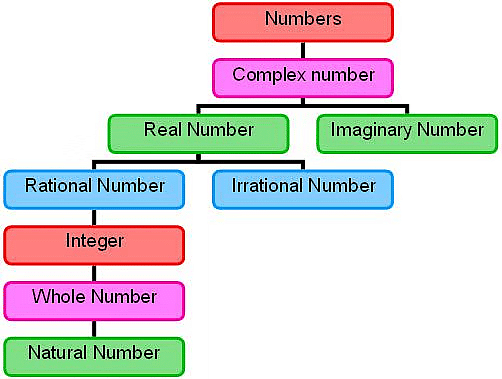
What are Whole Numbers?
Natural numbers refer to a set of positive integers and on the other hand, natural numbers along with zero(0) form a set, referred to as whole numbers. However, zero is an undefined identity that represents a null set or no result at all.
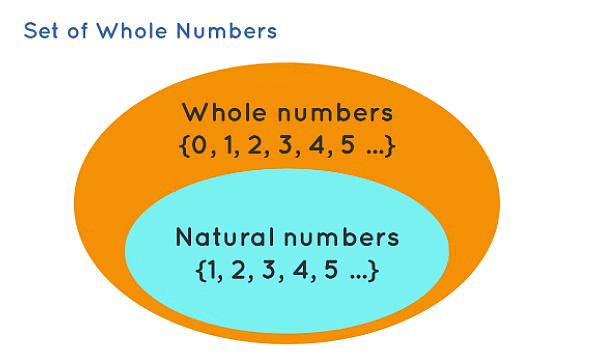
- The whole numbers are a set of numbers without fractions, decimals, or even negative integers. It is a collection of positive integers and zero.
- The symbol to represent whole numbers is the alphabet ‘W’ in capital letters, such as W = 0, 1, 2, 3, 4, 5, 6, 7, 8, 9, 10,…
- The primary difference between natural and whole numbers is zero.
Smallest Whole Number
Whole numbers start from 0 (from the definition of whole numbers). Thus, 0 is the smallest whole number.
- The concept of zero was first defined by a Hindu astronomer and mathematician Brahmagupta in 628.
- In simple language, zero is a number that lies between the positive and negative numbers on a number line.
- As such zero carries no value, though it is used as a placeholder. So zero is neither a positive number nor a negative number, but it is an even number.
Whole Numbers Vs Natural Numbers
From the above definitions, we can understand that every whole number other than 0 is a natural number.
- Also, every natural number is a whole number.
- So, the set of natural numbers is a part of the set of whole numbers or a subset of whole numbers.
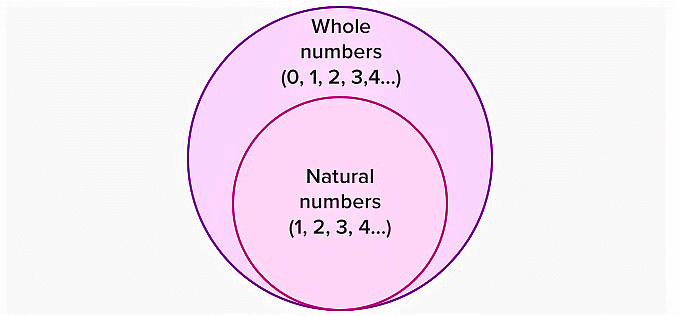 Set of Whole Numbers
Set of Whole Numbers
Difference Between Whole Numbers and Natural Numbers
Let's understand the difference between whole numbers and natural numbers through the table given below:
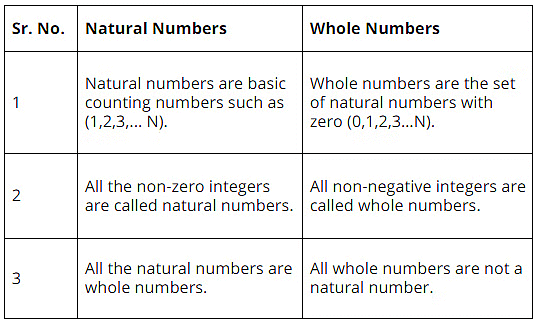
The Number Line
The set of natural numbers and the set of whole numbers can be shown on the number line as given below.
- All the positive integers or the integers on the right-hand side of 0, represent the natural numbers, whereas all the positive integers and zero, altogether represent the whole numbers.
- Both sets of numbers can be represented on the number line as follows:

What are the Properties of Whole Numbers?
Operations on whole numbers: addition, subtraction, multiplication, and division, lead to four main properties of whole numbers that are listed below:
- Closure Property
- Associative Property
- Commutative Property
- Distributive Property
Closure Property
- The sum and product of two whole numbers is always a whole number. The closure property of W is stated as follows: For all a,b∈W: a+b∈W and a×b∈W
- Division by Zero
The division of a whole number by o is not defined, i.e., if x is a whole number then x/0 is not defined. - Multiplication by Zero
When a whole number is multiplied to 0, the result is always 0, i.e., x.0 = 0.x = 0.
Associative Property
- The sum or product of any three whole numbers remains the same though the grouping of numbers is changed.
- The associative property of W is stated as follows: For all a,b,c∈W: a+{b+c}={a+b}+c and a×{b×c}={a×b}×c. For example, 10 + (7 + 12) = (10 + 7) + 12 = (10 + 12) + 7 = 29.
Commutative Property
- The sum and the product of two whole numbers remain the same even after interchanging the order of the numbers.
- The commutative property of W is stated as follows: For all a,b∈W: a+b=b+a and a×b=b×a. This property states that a change in the order of addition does not change the value of the sum.
- Let a and b be two whole numbers, commutative property states that a + b = b + a. For example, a = 10 and b = 19 ⇒ 10 + 19 = 29 = 19 + 10.
- It means that the whole numbers are closed under addition. This property also holds true for multiplication, but not for subtraction or division. For example: 7 x 9 = 63 or 9 x 7 = 63
Distributive Property
- The distributive property explains how multiplication interacts with addition or subtraction.
- It shows that when you multiply a number by the sum or difference of two numbers, it's the same as multiplying that number by each of the numbers separately and then adding or subtracting the results.
- This property can be written as: a × (b +c) = (a × b)+ (a × c) for addition and a × (b − c) = (a × b) − (a × c) for subtraction.
For example, if a = 10, b = 20, and c = 7, then: 10 × (20 7) = 270 and (10 × 20) (10 × 7) = 200 70 = 270.
Similarly, for subtraction: 10 × (20 − 7) = 130 and (10 × 20) − (10 × 7) = 200 − 70 = 130.
Identity(For Addition and Multiplication)
Additive Identity
When a whole number is added to 0, its value remains unchanged, i.e., if x is a whole number then x + 0 = 0 + x = x
Multiplicative Identity
When a whole number is multiplied by 1, its value remains unchanged, i.e., if x is a whole number then x.1 = x = 1.x
Patterns
Patterns are used for easy verbal calculations and to understand the numbers better.
We can arrange the numbers using dots in elementary shapes like triangle, square, rectangle, and lines.
1. We can arrange every number using dots in a line
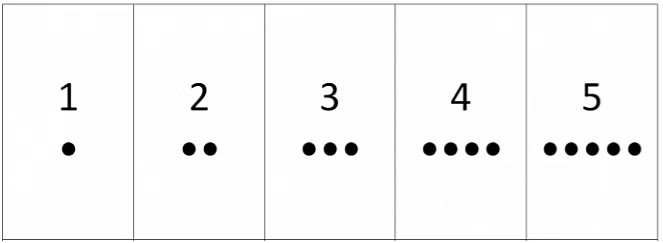
2. We can arrange some numbers using a rectangle.
Example: 6, 8, 10

3. We can arrange some numbers using a square.
Example: 4, 9, 16

4. We can arrange some numbers using a triangle.
Example: 3, 6, 10, 15, 21

Use of Patterns
Patterns can be used to simplify the process.
1. 123 + 9 = 123 + 10 - 1 = 133 -1 = 132
123 + 99 = 123 + 100 – 1 = 223 – 1 = 222
2. 83 × 9 = 83 × (10-1) = 830 – 83 = 747
83 × 99 = 83 × (100-1) = 8300 – 83 = 8217
Important Points
- 0 is a whole number but it is NOT a natural number.
- Negative numbers, fractions, and decimals are neither natural numbers nor whole numbers unless they can be simplified as a natural number or whole number.
- W is closed, associative, and commutative under both addition and multiplication (but not under subtraction and division).
Questions For You
Q.1. Write three consecutive whole numbers occurring just before 320001.
Ans:
The three consecutive whole numbers occurring just before 320001 are:
320001−1 = 320000−1 = 319999−1 = 319998
These are : 320000, 319999, 319998
Q.2. Find the coordinates of points A, B, C, D from the following graph.
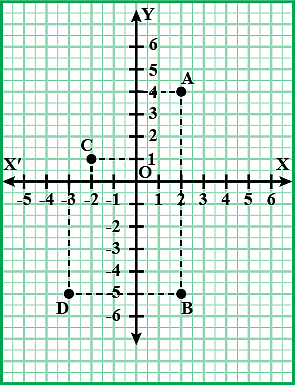
Ans:
Q.3. Find the following products, using distributive laws: 472×1097
Ans: Using distributive law of multiplication over addition
|
82 videos|273 docs|69 tests
|
FAQs on Notes: Whole Number - Mathematics & Pedagogy Paper 2 for CTET & TET Exams - CTET & State TET
| 1. What is the difference between predecessor and successor of whole numbers? |  |
| 2. What are whole numbers and how are they represented on the number line? |  |
| 3. What are the properties of whole numbers, specifically the identity properties for addition and multiplication? |  |
| 4. How do patterns play a role in understanding whole numbers? |  |
| 5. What are some important points to remember about whole numbers? |  |




















